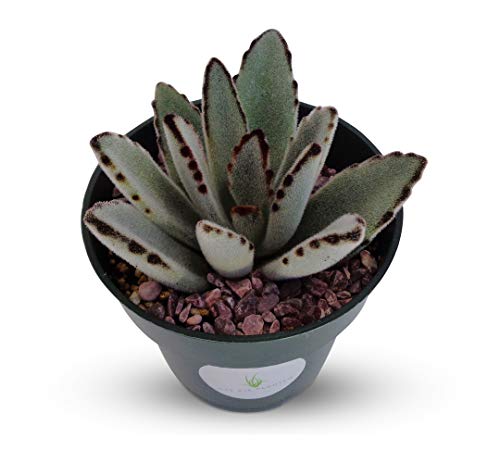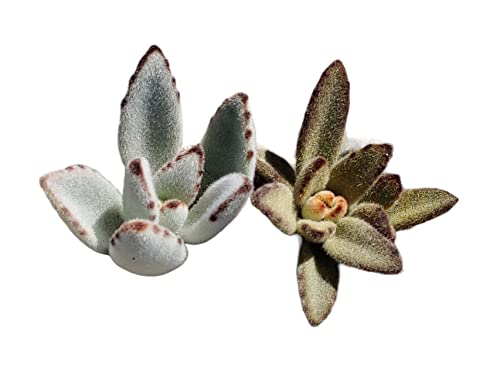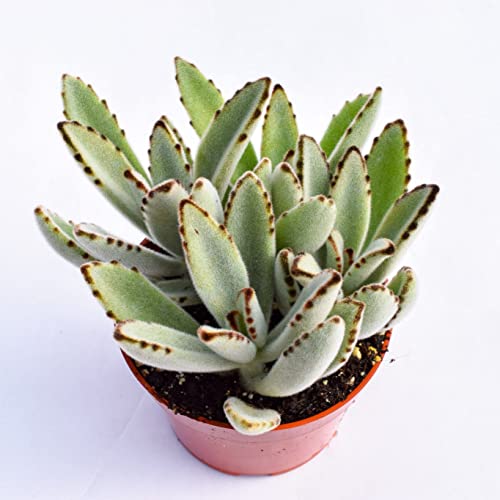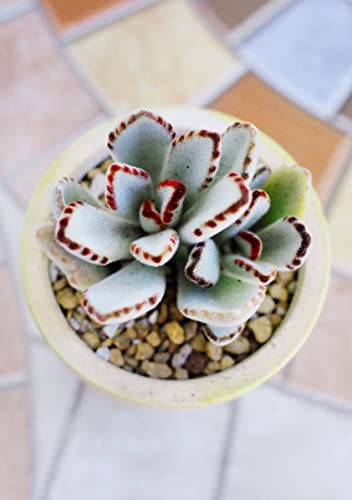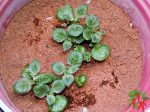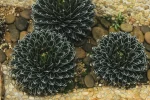This post contains affiliate links. If you buy something from one of our links we may earn a commission. Thanks
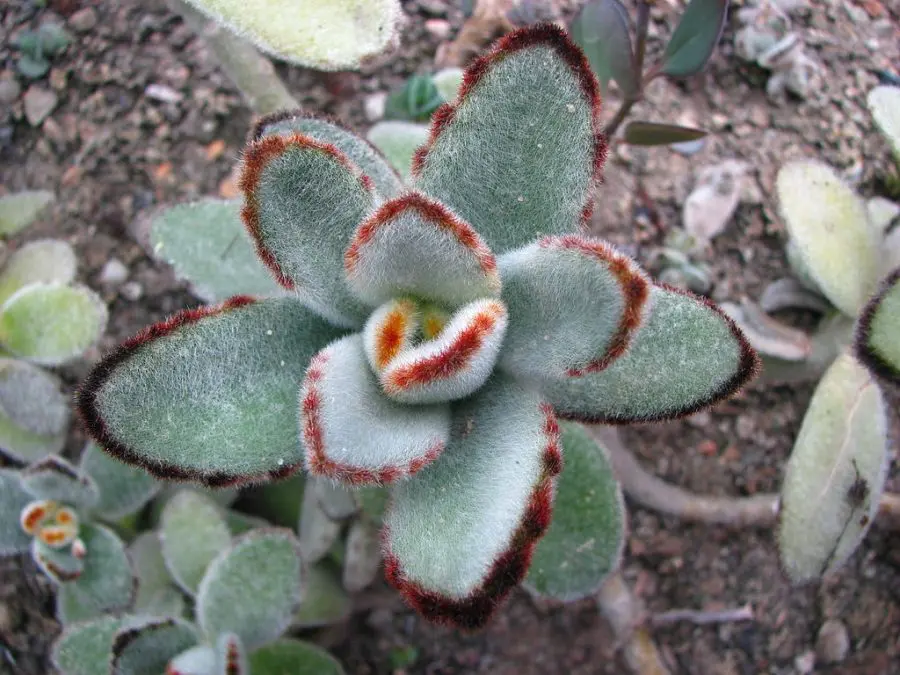
Discover the secrets to successful Panda Plant care with our comprehensive guide!
From soil to propagation, we’ve got you covered. Let’s help your Panda Plant thrive!
Caring for Panda Plant or Kalanchoe tomentosa involves placing it in a bright location with indirect sunlight and using well-draining soil. Water sparingly, allowing the soil to dry between waterings. Fertilize lightly during the growing season and avoid high humidity as it prefers a drier environment.
Looking for a low-maintenance houseplant that adds a touch of whimsy to your space?
Enter the Panda Plant or Kalanchoe tomentosa! With its fuzzy leaves and unique appearance, it’s no wonder this succulent is growing in popularity.
But how do you ensure your Panda Plant thrives in your home? Fear not, we’ve got you covered with this ultimate guide to Panda Plant care.
Get ready to unleash your green thumb and become a Panda Plant pro!
An Introduction To Panda Plant Care
 Have you recently added a Panda Plant to your collection of houseplants, but you’re not sure where to start with care?
Have you recently added a Panda Plant to your collection of houseplants, but you’re not sure where to start with care?
Whether you’re new to plant parenting or just want to ensure you’re giving your Panda Plant the best care possible, you’ve come to the right place!
You can buy your Panda Plant here on Amazon
In this guide, we’ll cover everything you need to know about Panda Plant care, from its ideal lighting and watering requirements to common problems you might encounter.
With our tips and tricks, you’ll be well on your way to becoming a Panda Plant expert in no time. Let’s dive in!
What Are Succulent Plants?
Succulent plants are a diverse group of plants that have adapted to store water in their leaves, stems, or roots.
These plants come in all shapes and sizes and are known for their low-maintenance qualities.
Panda Plant’s Succulent Features
Like all succulent plants, the Panda Plant is adapted to store water in its leaves, allowing it to withstand periods of drought.
This adaptation gives the leaves of the Panda Plant a thick, fleshy texture, which gives them their distinctive appearance.
The Importance of Succulent Care for Panda Plants
While succulent plants are known for their low-maintenance qualities, they still require proper care to thrive.
For Panda Plants, this means providing them with the right amount of light, water, and soil to ensure their health and longevity.
Proper succulent care not only helps your Panda Plant look its best but also helps it live its best life.
Panda Plant Benefits
Did you know that beyond their unique appearance, Panda Plants offer a few benefits that make them a great addition to any home?
These succulents have air-purifying qualities, which help to improve indoor air quality by removing harmful toxins.
Additionally, studies have shown that having houseplants, like the Panda Plant, can reduce stress and increase productivity.
In this section, we’ll explore the benefits of caring for a Panda Plant, and why it’s not just a pretty face!
Air-Purifying Qualities of Panda Plants
Did you know that the Panda Plant is one of several houseplants that can improve indoor air quality?
These succulent plants have been shown to remove harmful toxins like formaldehyde and benzene from the air, making them a great choice for anyone looking to breathe cleaner air in their home.
By caring for a Panda Plant, you’re not just adding a touch of green to your space – you’re also doing your lungs a favor!
Health Benefits of Having Panda Plants in the House
In addition to their air-purifying qualities, having houseplants like the Panda Plant can offer a range of health benefits.
Studies have shown that being around plants can help reduce stress, improve mood, and increase productivity.
By bringing a Panda Plant into your home, you’re creating a more welcoming and healthier environment for you and your loved ones.
Panda Plant Varieties
 If you’re looking to add a unique touch to your plant collection, look no further than the Panda Plant! With its distinctive appearance, this succulent is sure to stand out in any room.
If you’re looking to add a unique touch to your plant collection, look no further than the Panda Plant! With its distinctive appearance, this succulent is sure to stand out in any room.
What you may not know is that there are several different Panda Plant varieties available, each with its own unique characteristics.
In this section, we’ll explore some of the most popular Panda Plant varieties and what sets them apart.
Get ready to discover your new favorite plant!
Overview of Different Panda Plant Cultivars
While the Kalanchoe tomentosa species is commonly known as the Panda Plant, there are several different cultivars available, each with its own unique characteristics.
These varieties come in different colors, textures, and sizes, making them a fun addition to any plant collection.
Characteristics of Each Variety
Some of the most popular Panda Plant varieties include the ‘Chocolate Soldier,’ which features a deep brown hue on its leaves, and the ‘Golden Girl,’ which has a silver-green hue with golden edges.
The ‘Black Tie’ variety features a striking black edge on its leaves, while the ‘Teddy Bear’ has soft, fuzzy leaves that look like teddy bear ears.
By comparing the different Panda Plant varieties, you’re sure to find the perfect plant to suit your tastes and home décor.
Panda Plant Care In A Nutshell
In a hurry? Here is a quick rundown on what you should know to care for your Panda Plant. We will cover these topics in more detail later in the post.
Panda Plant Light Requirements
Like all plants, Panda Plants require proper lighting to thrive. These plants prefer bright, indirect light, making them perfect for a spot near a window.
However, too much direct sunlight can damage the leaves, so it’s important to find the right balance.
Panda Plant Soil
The right soil is essential for the health of your Panda Plant. These succulents prefer well-draining soil that allows excess water to drain away quickly.
A mixture of cactus soil and perlite or sand can create the ideal growing environment for your Panda Plant.
Panda Plant Watering
One of the most critical aspects of Panda Plant care is proper watering.
These succulents are drought-tolerant and can store water in their leaves, so it’s important not to overwater them.
Watering once every 2-3 weeks during the growing season should be sufficient.
Panda Plant Propagation
If you want to share the joy of your Panda Plant with friends and family, propagation is a simple and rewarding process.
These plants can be propagated by stem cuttings or leaf cuttings, making it easy to create new plants from existing ones.
Panda Plant Succulent Care The Nitty Gritty
If you’re looking for a houseplant that’s both beautiful and low-maintenance, look no further than the Panda Plant!
As a succulent, the Panda Plant is adapted to store water in its leaves, allowing it to thrive in dry conditions.
In this section, we’ll go into more depth and explore what it means to care for a succulent plant like the Panda Plant, including its unique features and the benefits of proper succulent care.
With these tips, you’ll be well on your way to helping your Panda Plant thrive!
Panda Plant Light Requirements
One of the most critical aspects of Panda Plant care is providing the right amount of light.
Like all plants, the Panda Plant requires proper lighting to thrive.
These plants prefer bright, indirect light, making them perfect for a spot near a window.
However, too much direct sunlight can damage the leaves, so finding the right balance is essential.
In this section, we’ll explore the ideal lighting requirements for your Panda Plant and how to ensure it receives the right amount of light to thrive.
Explanation of Panda Plant’s Light Requirements
Providing the right amount of light is crucial to the health of your Panda Plant.
These plants prefer bright, indirect light, which means they need a spot near a window or other source of natural light.
While they can tolerate some direct sunlight, too much can damage their leaves, so finding the right balance is key.
Importance of Providing Proper Lighting for Panda Plants
Proper lighting is essential for the health and growth of your Panda Plant.
Without enough light, your plant may become leggy or develop discolored leaves.
On the other hand, too much direct sunlight can scorch the leaves, damaging the plant.
By providing the right amount of light, you’re ensuring that your Panda Plant has everything it needs to thrive.
Tips for Adjusting Lighting for Indoor and Outdoor Panda Plants
If you’re growing your Panda Plant indoors, make sure to place it in a spot with bright, indirect light.
If your plant isn’t getting enough light, you may need to supplement with artificial light sources, like grow lights.
For outdoor Panda Plants, make sure to find a spot with bright, indirect light and some protection from the harsh afternoon sun.
If your plant is getting too much direct sunlight, consider moving it to a shadier spot or providing some shade with a sheer curtain or outdoor umbrella.
With a little bit of experimentation, you can find the perfect spot for your Panda Plant to thrive.
Panda Plant Soil
When it comes to caring for your Panda Plant, choosing the right soil mix is crucial.
These plants require a well-draining soil mix that allows for proper air circulation and moisture retention.
In this section, we’ll be using a soil mix made of coco coir and perlite, which offers the perfect balance of moisture and drainage for your Panda Plant.
Get ready to get your hands dirty and learn all about soil mix for your Panda Plant!
Overview of the Ideal Soil for Panda Plants
When it comes to soil for Panda Plants, the ideal mix is one that allows for proper drainage and air circulation.
A mix that is too heavy can lead to root rot, while one that is too light can dry out too quickly.
A mix of coco coir and perlite offers the perfect balance of moisture retention and drainage for your Panda Plant.
Explanation of Soil Components
Coco coir is a popular alternative to peat moss and is made from the fibrous outer husk of coconuts.
It’s a renewable resource that is environmentally friendly and provides excellent moisture retention.
Perlite, on the other hand, is a lightweight volcanic rock that provides excellent drainage and helps to aerate the soil.
Tips for Selecting the Right Soil for Panda Plants
When selecting soil for your Panda Plant, look for a mix that is well-draining and has good moisture retention.
Avoid mixes that are too heavy or contain large amounts of organic matter, which can retain too much moisture and lead to root rot.
Additionally, make sure to repot your Panda Plant every few years to ensure it has fresh soil and room to grow.
With the right soil mix, your Panda Plant is sure to thrive!
Panda Plant Watering
Proper watering is one of the most important aspects of caring for your Panda Plant.
These succulent plants are adapted to withstand periods of drought, which means they don’t need to be watered as frequently as other plants.
However, providing too much or too little water can be detrimental to their health.
In this section, we’ll explore everything you need to know about watering your Panda Plant, including how much water to give, when to water, and how to tell if your plant needs a drink.
Let’s dive in!
Explanation of Proper Watering Techniques for Panda Plants
Proper watering is essential for the health of your Panda Plant.
These plants prefer to be watered deeply but infrequently, which means you should wait until the soil is completely dry before watering.
When you do water, make sure to thoroughly saturate the soil and allow excess water to drain out of the pot.
Signs of Overwatering and Underwatering Panda Plants
Overwatering and underwatering can both be detrimental to the health of your Panda Plant.
Signs of overwatering include mushy, brown leaves, while signs of underwatering include dry, crispy leaves.
By paying attention to your plant’s leaves and soil, you can adjust your watering schedule accordingly.
Tips for Adjusting Watering Schedules for Different Panda Plant Environments
If you’re growing your Panda Plant indoors, make sure to avoid placing it in a spot with constant drafts or humidity.
If your plant is in a particularly dry environment, you may need to water more frequently, while plants in humid environments may require less frequent watering.
Additionally, outdoor Panda Plants may need more water during hot summer months and less during cooler seasons.
By adjusting your watering schedule to the specific needs of your Panda Plant and environment, you’re ensuring it has everything it needs to thrive.
Panda Plant Propagation
Propagation is a fun and rewarding way to expand your collection of Panda Plants.
These plants are relatively easy to propagate, meaning you can create new plants from your existing ones without too much hassle.
In this section, we’ll explore the different methods of Panda Plant propagation, including stem cutting and leaf cutting, and provide step-by-step instructions on how to propagate your Panda Plant.
Get ready to grow your plant family!
Description of Panda Plant Propagation Methods
There are two primary methods of Panda Plant propagation: stem cutting and leaf cutting.
Stem cutting involves cutting a healthy stem from your plant and allowing it to root in water or soil, while leaf cutting involves removing a healthy leaf and planting it in the soil until it produces roots and a new plant.
Explanation of Propagation Benefits
Propagation is a great way to expand your plant collection without spending a lot of money.
It also allows you to create new plants from existing ones, meaning you can continue to enjoy your favorite plants for years to come.
Additionally, propagating your Panda Plant can help to refresh the soil and promote new growth.
Step-by-Step Guide to Panda Plant Propagation
To propagate your Panda Plant through stem cutting, first, take a healthy stem cutting and remove the lower leaves.
Place the cutting in water or soil, making sure to keep it moist but not waterlogged.
Wait for the cutting to produce roots and new growth before transplanting it to its own pot.
For leaf cutting, take a healthy leaf and plant it in soil, making sure the cut end is buried in the soil.
Keep the soil moist and wait for the leaf to produce roots and new growth before transplanting it to its own pot.
By following these steps, you’ll have a whole new Panda Plant in no time!
Panda Plant Problems
While Panda Plants are relatively easy to care for, they can still run into some common problems.
From pests to diseases to environmental factors, there are several things that can affect the health of your Panda Plant.
In this section, we’ll explore some of the most common Panda Plant problems and how to identify and treat them.
Don’t worry – with a little bit of know-how, you can get your Panda Plant back to its happy, healthy self in no time!
Overview of Common Panda Plant Problems
While Panda Plants are relatively hardy, they can still experience problems.
Some common issues include pests like spider mites or mealybugs, diseases like root rot or powdery mildew, and environmental factors like overwatering or poor lighting.
Explanation of Causes of Problems, Such as Pests or Diseases
Pests like spider mites and mealybugs can be introduced to your plant through contaminated soil or new plants.
Diseases like root rot and powdery mildew are often caused by overwatering or poor air circulation.
Environmental factors like too much or too little light, extreme temperatures, or improper soil can also lead to problems with your Panda Plant.
Tips for Addressing Panda Plant Problems
The best way to address problems with your Panda Plant is to identify the issue and take action.
For pests, you may need to use an insecticidal soap or neem oil to get rid of them.
For diseases, you may need to adjust your watering habits or treat the plant with a fungicide.
Environmental factors can often be addressed by adjusting the plant’s placement or soil mix.
By paying close attention to your plant and addressing any problems as soon as they arise, you can help to ensure its long-term health and vitality.
Insect Pests And Treatments
Overview of Common Insect Pests
There are a few common insect pests that can affect Panda Plants, including spider mites and mealybugs.
Spider mites are tiny insects that can be identified by the fine webbing they create around leaves and stems.
Mealybugs, on the other hand, are small, white, fluffy insects that can often be found in the nooks and crannies of your plant.
Treatment for Spider Mites
To treat spider mites, first, isolate the infected plant to prevent the infestation from spreading.
Then, gently wash the plant with a solution of dish soap and water, making sure to cover both the tops and bottoms of the leaves.
Alternatively, you can use an insecticidal soap or neem oil to treat the plant.
Treatment for Mealybugs
To treat mealybugs, first, remove any heavily infested leaves or stems.
Then, gently wash the plant with a solution of water and rubbing alcohol or use an insecticidal soap or neem oil.
Repeat the treatment every week or so until the infestation is under control.
Remember, prevention is key when it comes to insect pests.
Make sure to regularly inspect your plant for any signs of infestation and isolate any infected plants immediately.
Additionally, avoid overwatering your plants and provide adequate air circulation to prevent pest problems in the first place.
Leggy Panda Plant
If your Panda Plant is looking a bit leggy, with long, thin stems and few leaves, don’t worry, you’re not alone.
Leggy growth is a common problem with Panda Plants and can be caused by a variety of factors, including improper lighting or lack of pruning.
In this section, we’ll explore the causes of leggy growth in Panda Plants and provide tips for getting your plant back into tip-top shape. Let’s get started!
Description of Leggy Panda Plants and Causes of Legginess
Leggy growth in Panda Plants is characterized by long, thin stems with few leaves.
This can be caused by a variety of factors, including inadequate lighting, improper watering, or a lack of pruning.
When Panda Plants don’t receive enough light, they’ll stretch toward the light source, resulting in leggy growth.
Overwatering or underwatering can also contribute to legginess, as can a lack of pruning or pinching back.
Tips for Preventing Legginess and Promoting Healthy Growth
The best way to prevent legginess in your Panda Plant is to provide it with the right conditions for healthy growth.
Make sure to provide your plant with bright, indirect light and avoid placing it in direct sunlight or too much shade.
Water your plant only when the soil is dry and make sure to avoid overwatering, which can lead to root rot and other problems.
Additionally, make sure to regularly pinch back your plant to encourage branching and fuller growth.
If your Panda Plant is already leggy, don’t worry – you can still help it to recover.
Start by pruning back any long, thin stems to encourage new growth.
Then, make sure to provide the plant with proper lighting and watering to promote healthy growth.
With a little bit of TLC, your leggy Panda Plant can bounce back and become a lush, vibrant addition to your plant collection.
Panda Plant Leaves Curling
If you’ve noticed your Panda Plant’s leaves curling or wilting, it can be a cause for concern.
Curling leaves are a sign that something is amiss with your plant but don’t worry. There are several things you can do to help your Panda Plant recover.
In this section, we’ll explore the causes of leaf curling in Panda Plants and provide tips for getting your plant back to its happy, healthy self. Let’s dive in!
Explanation of Causes of Curling Leaves in Panda Plants
Curling leaves in Panda Plants can be caused by a variety of factors, including overwatering, underwatering, too much or too little light, pests, or diseases.
Overwatering can lead to root rot, which can cause leaves to curl and wilt while underwatering can cause leaves to dry out and curl.
Too much or too little light can also cause leaf curling, as can pest infestations or diseases like powdery mildew.
Tips for Addressing Leaf Curling Issues in Panda Plants
To address leaf curling in your Panda Plant, start by examining the plant to determine the cause of the problem.
If you suspect overwatering or underwatering, adjust your watering schedule accordingly.
If you think the plant isn’t getting enough light, move it to a brighter location or provide supplemental lighting.
For pest or disease issues, use an appropriate treatment to get rid of the problem.
In some cases, pruning back damaged or diseased leaves may also help to promote healthy growth.
Remember, prevention is key when it comes to leaf curling issues, so make sure to provide your Panda Plant with proper care and regular maintenance to keep it healthy and happy.
Repotting Panda Plant
Repotting your Panda Plant is an important part of its care routine, as it allows the plant to continue growing and thriving.
As a general rule, you should plan to repot your Panda Plant once every 1-2 years, or whenever you notice that it’s outgrowing its current pot.
In this section, we’ll explore the ins and outs of repotting your Panda Plant, including how often to do it and the steps involved in the process.
How Often to Repot Your Panda Plant
As mentioned, you should plan to repot your Panda Plant once every 1-2 years, or whenever it outgrows its current pot.
Signs that it’s time to repot your plant include roots growing out of the drainage holes, the plant becoming top-heavy and unstable, or the soil becoming compacted and unable to hold water.
Steps to Repotting Your Panda Plant
To repot your Panda Plant, start by selecting a new pot that’s slightly larger than the current one.
Fill the bottom of the pot with a layer of fresh potting mix, then gently remove the plant from its current pot, being careful not to damage the roots.
If the roots are tightly packed, gently loosen them with your fingers or a small tool.
Place the plant in the new pot and fill in around the edges with fresh potting mix, making sure to leave enough space at the top for watering.
Water the plant thoroughly and place it in a bright, indirect location to recover.
Remember, repotting can be stressful for plants, so make sure to give your Panda Plant some extra TLC in the weeks following the process.
Water it regularly and provide it with the right conditions for healthy growth, and it should continue to thrive in its new home.
Panda Plant FAQs
If you’re fascinated by succulents, the Panda Plant or Kalanchoe tomentosa is a great addition to your collection.
Known for its unique, velvety leaves, this plant is not only beautiful but also relatively easy to care for.
However, there are some care tips you should know to help your Panda Plant thrive.
We’ve gathered frequently asked questions to guide you in maintaining the health and aesthetic of your plant.
Q: How often should I water my Panda Plant?
A: Water your Panda Plant when the top inch of soil feels dry to the touch. Overwatering can lead to root rot.
Q: Does the Panda Plant need direct sunlight?
A: No, Panda Plants prefer bright, indirect light. Direct sunlight can scorch the leaves.
Q: Should I fertilize my Panda Plant?
A: During the growing season, you can fertilize your Panda Plant once a month with a diluted balanced fertilizer. Skip fertilizing in the winter.
Q: How do I propagate a Panda Plant?
A: Propagation is easily done by leaf cuttings. Simply remove a healthy leaf and let it callous for a couple of days before planting it in soil.
Panda Plant Care Final Thoughts
Congratulations, you’ve reached the end of our guide to Panda Plant care!
We hope that this post has provided you with all the information you need to keep your Panda Plant healthy and happy.
From understanding the plant’s succulent nature to providing proper lighting and watering, we’ve covered all the essential topics for caring for your Panda Plant.
Remember, caring for plants can be a rewarding experience, but it also requires patience, attention, and care.
With the right approach, your Panda Plant can thrive and bring beauty to your home for years to come. Thanks for reading, and happy planting!
Recap of Key Panda Plant Care Tips and Guidelines
Let’s recap, the key tips and guidelines for caring for your Panda Plant:
• Understanding the plant’s succulent nature and providing the right soil mix
• Providing bright, indirect lighting and avoiding direct sunlight or too much shade
• Watering only when the soil is dry and avoiding overwatering or underwatering
• Regularly pruning and pinching back to encourage full growth and prevent legginess
• Addressing common problems like pests or diseases as soon as they arise
• Repotting every 1-2 years to allow for continued growth and health
By following these guidelines and providing your Panda Plant with proper care and attention, you can ensure that it thrives and adds beauty to your home or office.
Final Thoughts on the Benefits of Caring for Panda Plants
Caring for Panda Plants isn’t just about keeping them healthy. It also offers a range of benefits for you and your environment.
As we’ve discussed in previous sections, Panda Plants have air-purifying qualities and can help to improve air quality in your home or office.
They’re also easy to care for and can add a touch of natural beauty to any space.
So, by caring for your Panda Plant, you’re not just helping the plant to thrive – you’re also helping yourself and your environment. Thanks for reading, and happy planting!
You can buy your Panda Plant here on Amazon
Flaming Katy Plant Care Indoors (Kalanchoe blossfeldiana)
Read more: 20 Benefits Of Keeping Indoor Plants For Improved Lifestyle




